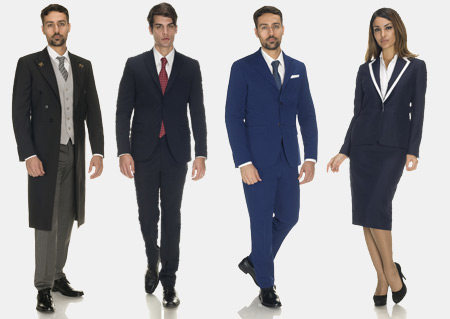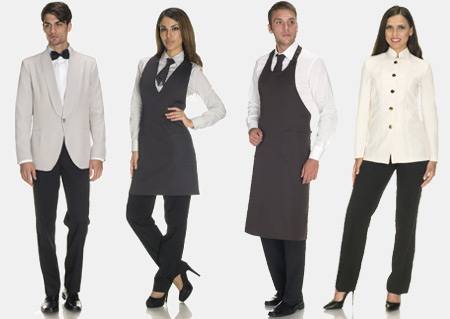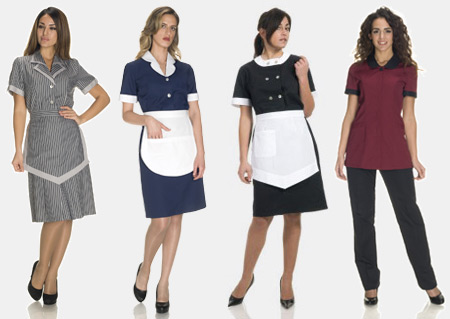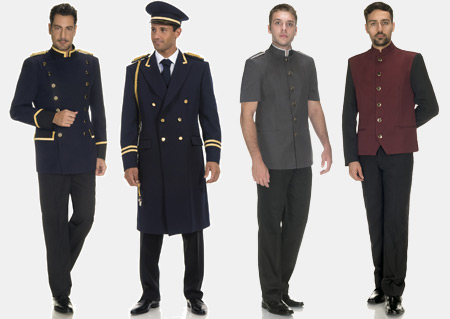In a hotel, the uniforms for the staff are very important, since they contribute to provide the professional image to be promoted.
Of course, you can’t tell a book by the cover, but the cover influences the readers’ first impression. The same happens for hotels, where the first impact is essential, to justify the trust the guests put on the hotel when they booked it.
Hotel uniforms: not all the staff is the same
Before buying hotel uniforms, it’s necessary to distinguish, because receptionists cannot wear the same professional wear of waiters. More than carrying out different tasks, some of which have a direct relationship with customers while others don’t have it, the different professional figures employed in a hotel have different needs.
Banally, chambermaids have to wear more comfortable and less bulky uniforms than doorkeepers, for obvious reasons: they clean the rooms, so their uniforms have to be practical and comfortable and make their movements easier. We know that such information can appear superfluous, but it happens often that those who order the professional wear for hotels undervalue this aspect.
In this article, therefore, we’d like to supply all the information you need before ordering the uniforms for your hotel, making a clear distinction among the tasks carried out by the hotel’s staff.
Hotel uniforms for receptionists: model, fabrics, colours
As previously mentioned, receptionists are the first contact point with the guests of the hotel. The uniforms for receptionists, therefore, should contribute to make the guests comfortable, but also provide a certain authority to the staff.
Types of uniforms for receptionists
The receptionists of a hotel usually wear formal suits or dresses (jacket, shirt, tie and classical trousers for men, skirt or trousers and jacket for women).
In the most exclusive hotels, furnished with a more classical and elaborated style, usually a lofty and elegant wear is chosen, that is the morning dress (tale coat), the stroller jacket and the frock coat – a typical garment of the second half of nineteenth century and beginning of the twentieth.
Models of uniforms for receptionists
The uniforms for receptionists should be sober, rigorous and never gaudy, even in the most modern models, but they cannot be completely disjointed from the contemporary trends of civil wear outfits.
Such as it happens in the “traditional” fashion, where every season has its own collection, characterized by different models, colours and decorations, also in case of professional wear we want to be always in current flow, continuously updating our catalogues and models available.
For example, to the range of uniforms for receptionists were recently added the slim-fit garments, characterized by jackets with narrower shoulders and close-fitting trousers.
Colours of uniforms for receptionists
Except for some international chains of hotels which prefer gaudier colours, the uniforms for receptionists are made with sober and elegant colours, such as blue, grey and black. The purpose is to give an idea of seriousness and authority to the Front Office staff and this is simpler by using such colours.
These three colours represent a basis, more than a standard, and are employed in dark shades, with the possibility of using lighter shades in summer.
Materials of the uniforms for receptionists
The choice of the material used to make the uniforms for receptionists derives from two aspects:
- The staff operates inside the structure, which is always air-conditioned, except for the resorts and holiday villages;
- A uniform should resist for long, more than being comfortable, as people wears it many hours a day.
Starting from these assumptions, we decided to use almost only the lightweight wool, or fabrics made of wool and synthetic fibre, which ensure a longer wear.
Lightweight wool is the ideal choice to make a garment which can be used all the year, thanks to its thermoregulating properties.
In resorts and holiday villages, as previously mentioned, people prefer to give up the jacket and wear a uniform made of trousers and shirt.
Hotel uniforms for waiters
We saw that the uniforms for receptionists are elegant, classic, formal, constant over time, while the uniforms for waiters are more varied.
Depending on the type of restaurant, and on the type of cooking proposed, the uniforms for waiters vary from classic solutions to more modern and colourful garments. Recently, it’s not strange to see uniforms for waiters where the classic jacket is replaced by an apron, and also in that case the models are really a lot.
We’ll try to outline for you the different types of uniforms for waiters.
Models of uniforms for waiters
As previously mentioned, the uniform for waiters is usually made of a jacket (for men) and a spencer (for women), which is the best solution for the restaurants of hotels, or of more modern solutions, such as mandarin collar jackets, perfect for catering.
Instead of the jacket, modern restaurants employ the aprons, which are usually very long – a bit shorter for women – and with bib.
Even if it wasn’t used any more in the hotels, recently we noticed a strong comeback of the waistcoat, in particular in some very trendy lounge bars, which want to create a vintage effect, even to remind the garments of the mixing masters of the past.
Colours of the uniforms for waiters
The most popular colours for the uniforms for waiters are cream – a real must – and black, used almost everywhere. Next to these two colours, new shades are periodically introduced, to follow the trends of the contemporary fashion.
In the last years, in fact, also other, more modern, colours are used, that is:
- ice grey;
- dark grey;
- sand;
- safari;
- white – this solution is perfect for summer.
Materials for the uniforms for waiters
The uniforms for waiters face an unavoidable side effect.
Working in contact with foods and drinks, it happens often that the uniforms are stained, that’s why they are produced considering the fact that they will be washed very often, in a washing machine, and that they have not to wear out in a short time.
For these reasons, they are usually made of 100% polyester, a synthetic fabric that ensures a higher duration of the garment. It can be washed in the washing machine without any problems and doesn’t crumple. The defect of the polyester is that it’s little breathable, as a consequence summer uniforms are usually lighter.
Hotel uniforms for chambermaids
As we mentioned in the first part of the article, the uniforms for chambermaids have to be comfortable to wear, practical and not very bulky. The reason is that the staff must be free to carry out its activities without any obstacles (just think of the movements necessary to make the beds or clean the floors).
However, the practicality of the garment shouldn’t entail a little attention to the aesthetic aspect, because we are always speaking of people employed in a hotel, which contribute to provide a refined professionalism image.
Chambermaids work in close contact with the guests of the hotel, so they should give a feeling of order, cleanliness and reliability.
Models of the uniforms for chambermaids
In the most refined hotels and structures, a close-fitting dress is used, or rather the classic comfortable-fitting coat, matched with the coordinated apron, with a merely aesthetical function. They can be ordered with or without collar, short-sleeved or three-quarter sleeved.
In holiday villages and lower category hotels, the practicality is considered most important, to the detriment of aesthetics, so the so-called poncho-style aprons are used.
Recently, in particular in some trendy structures, the classic dress has been replaced by a uniform made of tunic and trousers, much more practical and so preferred by chambermaids.
The customization and choice of the colour, in this case, has to be adapted to the style of the structure.
Colours of uniforms for chambermaids
Such as for hotel uniforms in general, sober colours are used for luxury hotels, or medium-high hotels, and brighter colours for holiday villages and lower-class hotels.
Until a few years ago, black characterized the uniform for “Turndown Service” – a practice typical of 5* hotels where the rooms are tidied up again during the dinner – even if in some structures today it’s used also for the daily service.
Materials of the uniforms for chambermaids
Such as it happens for waiters, also chambermaids tend to stain their uniforms, due to the cleaning of the rooms and the employment of chemical products and detergents, so also in this case the durability is a very important element.
The materials more used for these garments are:
- Cotton, which has the great advantage of being breathable and non-allergenic, but also the “defect” of being more expensive and subject to deterioration;
- The cotton-polyester bland (50% cotton and 50% polyester), an excellent compromise between the advantages/disadvantages of the cotton and the ones of a synthetic fabric;
- Polycotton, a 65% polyester and 35% cotton fabric, cheaper but more resistant to the continuous washing.
Hotel uniforms for porters
The porter is an easily recognizable professional figure that, in the collective imagination, has a particular wear. Before analysing in details the uniforms for porters, it’s important to make a distinction.
Porters, in fact, are divided into:
- porters in the hall: they usually have a “scenic” function and welcome the guests of the hotel taking care of their luggage;
- bellman: it’s a more operative kind of porter, who picks up the luggage and takes it to the room, more than supporting chambermaids for the most tiring tasks (for example, moving the furniture);
- doorman: it’s a figure present only in the most luxury structures (which are unusual in Italy); it’s a porter who welcomes the guests outside the hotel, opening the entrance door, the door of the car or of the taxi.
As you can imagine, the models vary depending on the task.
Models of uniforms for porters
The classical uniform for porters is made by the mandarin collar jacket, embellished with some accessories, such as stripes – that is borders in relief present on the collar and on the sleeves – buttons and “epaulette” – that is the braids on the shoulder. All these accessories are gold or silver (for the black uniforms).
The model is the classic one, used in the luxury structures that tend to customize it modifying the stripes, buttons or buttoning.
Colours of uniforms for porters
Being classic uniforms, the standard colours are navy blue, maroon, green and black.
Since porters work also outside the hotel, there is also a summer uniform for porters, with short-sleeved shirt or jacket made of a lighter fabric.
Materials of uniforms for porters
Such as for waiters, the uniforms for porters are made almost exclusively of 100% polyester. The reasons are the ones of above, that is more durability and the fact they don’t crumple and keep the colours unchanged even after several washings.
Common features of all hotel uniforms
In this article we tried to show you the different kinds of hotel uniforms, underlining their peculiarities, but there are even common features, that you should know before ordering them.
- The professional wear should have the same style of “common” garments, but it should be made with the purpose of lasting for long, improving for example the resistance to the peeling. Even buttons, hinges, threads and lining should resist more than common ones;
- It should be possible to buy the same uniform even after a long time, in case of new hiring, increase of the staff, or in case of replacement of the previous worn out ones. That’s why we strongly recommend not to buy products in non-specialized shops;
- The catalogue should include also the need of special sizes, a need that only a producer can satisfy.
As you see, buying hotel uniforms for receptionists, waiters, chambermaids and porters requires awareness and knowledge of the needs of the staff and of hotel.
We hope we provided you with useful information. In case of doubts, we are at your disposal.
Author: Ciro Corbara




